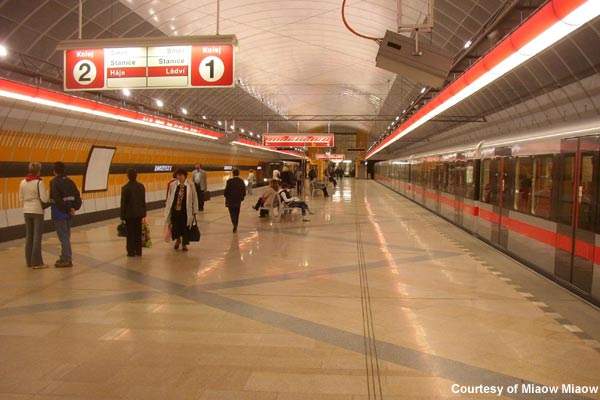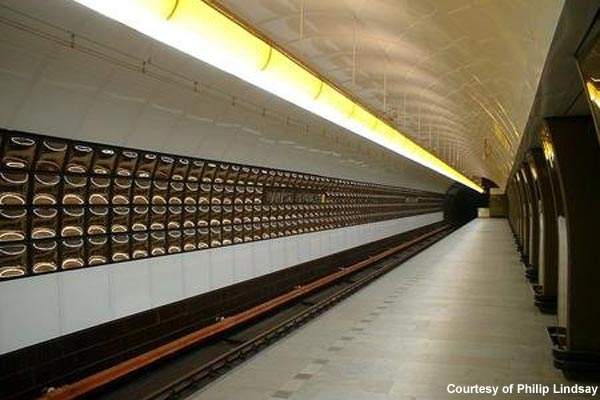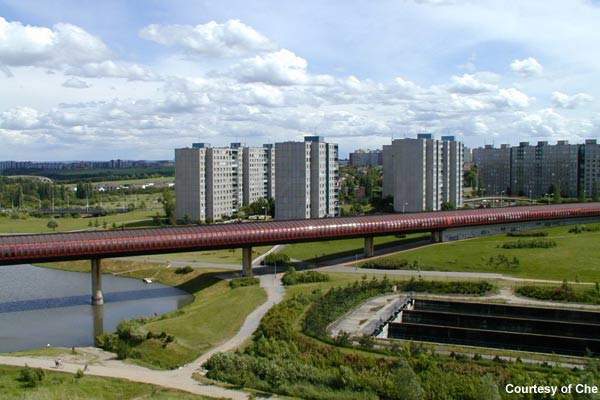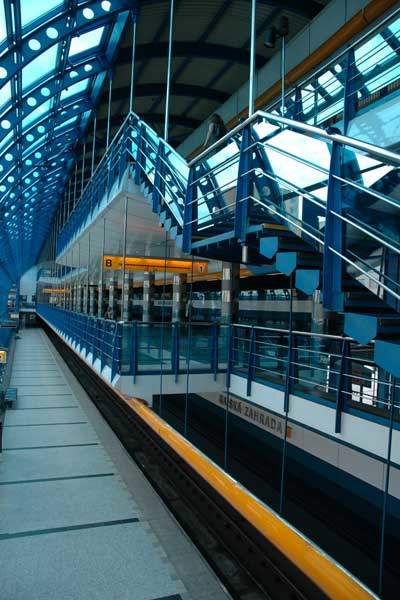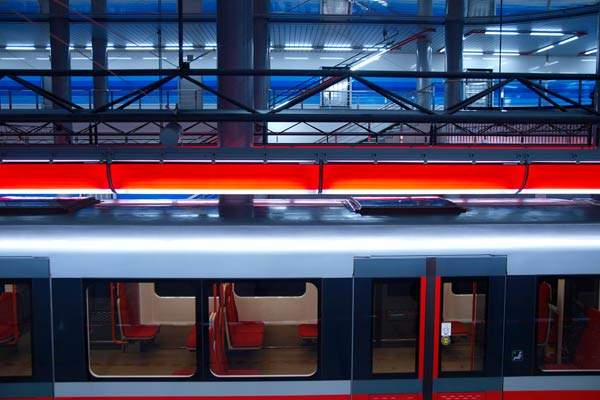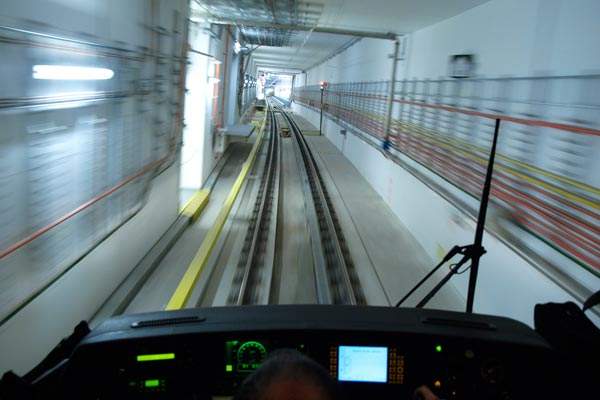As the sixth-busiest metro system in Europe, Prague Metro consists of roughly 60km of track, running largely underground, serving 57 stations. The network was extended in 2008 but the majority was built about 30 years ago. It currently serves over 620 million passengers a year.
It has three lines – Line A (green), Line B (yellow) and Line C (red) – that all meet together in the centre of the city at three interchange stations (Můstek, Muzeum and Florenc). The system is operated by the Prague Transport Company Co. Inc. (Dopravní podnik hlavního města Prahy a.s.) which also manages all modes of public transport in Prague, including trams and buses.
Trains operate from 5am until midnight every day at about two to three-minute intervals during peak hours and roughly four to ten-minute intervals during off-peak hours. The system is connected to commuter trains and buses forming a public transportation network that extends to the wider reaches of the city called Prague Integrated Transport.
Prague metro project
While the first section of Prague Metro began operating in 1974; Line C between Sokolovská (now Florec) and Kačerov stations, the first proposal to construct a sub-surface railway was made as far back as 1898. However, a number of proposals were refused by city authorities until the early 1960s when the government came under the influence of Soviet advisors and opted for a metro system above suggestions for an underground tramway.
Construction of the metro continued rapidly throughout the 1970s and 80s. In 1978, operations began on the second metro line (A) in the section Leninova (today Dejvická) to Náměstí Míru, which included deeply situated three-tunnel stations. By 1985, the basic network structure had been completed when the third line (B) began operations between Smíchovské Nádraží and Sokolovská (today Florenc).
In 1990, the names of 14 stations that encapsulated Communist ideology were changed to become more politically neutral. This included Leninova station which became Dejvická – renamed after a nearby street and surrounding neighbourhood.
Railway infrastructure
Since the basic network was introduced, all three tracks have been extended further from the city’s centre. In 1994, Line B was extended from Nové Butovice to Zličín and then in 1998 it was extended again from Českomoravská to Černý Most. Kolbenova and Hloubětín stations were opened in 2001.
In August 2002, Prague Metro was struck by severe flooding that also affected parts of Bohemia and other areas in Central Europe. In total, 19 stations were flooded, causing an estimated $200m in damage and bringing a partial collapse of the transport system in Prague. The affected sections of the metro remained out of service for several months with the last station – Křižíkova – only being reopened in March 2003.
Extension continued in 2004 with a northern expansion to Line C, which included the construction of new tunnels under the Vltata River and two additional stations; Kobylisy and Ládví. Line A was expanded further east in 2006, with the opening of a new station called Depo Hostivař, which was constructed in the building on an existing railway depot. The extension became the first segment of the line to be built above ground and not covered by a tunnel.
Most recently, Line C was extended further north-east in 2008 to connect the city centre with the housing blocks in Prosek. Three stations – Střížkov, Prosek and Letňany – were opened to support the expansion.
Rolling stock
Prague Metro’s C Line was initially served by E-series trains imported from the Soviet Union. Modelled on the A-series, which had been in existence since 1934, by the time the series was finally introduced to the first part of the Prague Metro in 1974, they were already a relatively outdated model.
The E-Series was introduced as three-car trains but was soon extended to four-cars. By 1979, it had been extended to five-cars – the maximum length to fit in Prague stations.
The last E-Series trains were delivered in 1979 and the model remained solely implemented on the C Line due to its inability to tackle the steep gradients found on the network’s other two lines.
The first trains of the series were retired in 1994 and by 1997 all models had been scrapped, except four cars that were preserved – one of which is now residing in Prague Transport Museum.
In order to meet the demands of the A Line, the Prague Public Transport Company asked the manufacturers for several improvements to the E-Series. In 1978, the new 81-71M was introduced – a modernised variant of the old Soviet trains, which went on to service the entire A Line and most of the B Line as well. In total, 507 cars were delivered for 101 five-car 81-71M trains between 1978 and 1990.
However, following the downfall of the communist regime in 1990, it was obvious that the old soviet trains – both the E-Series and 81-71M – were becoming obsolete and new rolling stock was required. The Siemens M1 therefore was introduced in 1998 and by 2003 had completely replaced all the older cars on Line C. By 2006, Siemens had completed the delivery of 48 ordered train sets, which fully covers the line’s operating needs. The trains were produced in Siemens Prague-based rolling stock production plant known as Siemens Kolejová Vozidla.
The two remaining lines currently operate with modernised versions of the 81-71M.
Signalling and communications
Prague Metro’s Line C is equipped with Siemens PA135 system, which provides automatic train speed control, reduces the time that train sets spend in individual stations, and reportedly allows optimal choice of braking distances. With the metro control system, it is possible to operate the trains at 85-second headways while adhering to all security conditions.
Siemens was selected to equip Line C with the system in 1997 and in 2005 was awarded a contract to supply a safety system for its extension linking Ladvi and Leetnany.
Prague Metro’s future
Following the completed extension to Line C, plans are in place to build a completely new line – Line D (blue), which would connect the city centre to the southern parts of Prague, namely the Nuslse quarter down to the suburban neighbourhoods of Krč, Libuš and Písnice. The first sections of the line are expected to begin operations in 2013. There have also been reports of a fifth line (E) being introduced at some point in the
future.
The planned extension to Line A, which is set to cost roughly $2bn, will also extend the network to those living in the western and north-western parts of the capital. It will eventually stretch as far as from Dejvice to Ruzyně International Airport.

